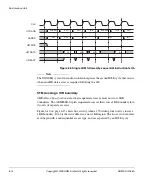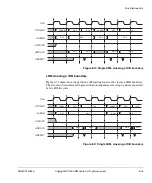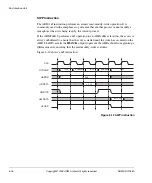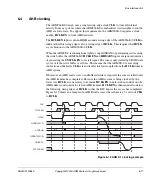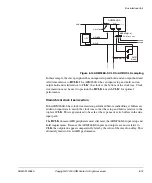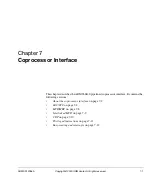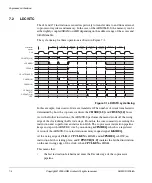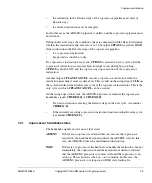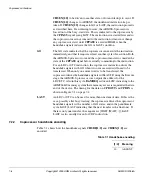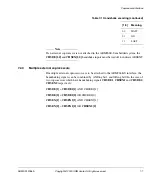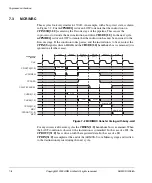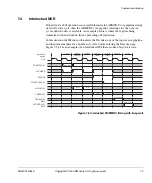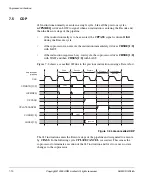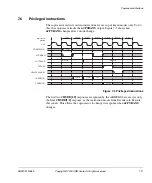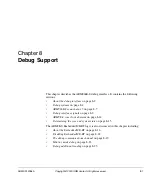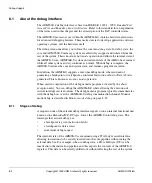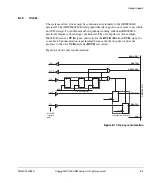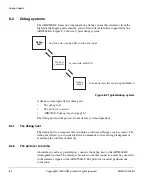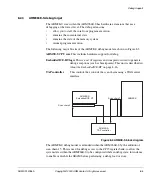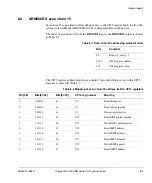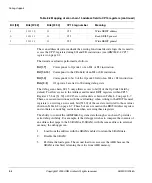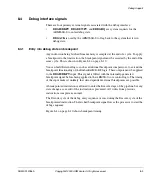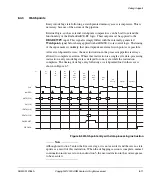
Coprocessor Interface
7-8
Copyright © 2000 ARM Limited. All rights reserved.
ARM DDI 0186A
7.3
MCR/MRC
These cycles look very similar to
STC
/
LDC
. An example, with a busy-wait state, is shown
in Figure 7-2. First
nCPMREQ
is driven LOW to denote that the instruction on
CPINSTR[31:0]
is entering the Decode stage of the pipeline. This causes the
coprocessor to decode the new instruction and drive
CHSDE[1:0]
. In the next cycle
nCPMREQ
is driven LOW to denote that the instruction has now been issued to the
Execute stage. If the condition codes passes, and the instruction is to be executed, the
CPPASS
signal is driven HIGH and the
CHSDE[1:0]
handshake bus is examined (it is
ignored in all other cases).
Figure 7-2 MCR/MRC transfer timing with busy-wait
For any successive Execute cycles the
CHSEX[1:0]
handshake bus is examined. When
the LAST condition is observed, the instruction is committed. In the case of a
MCR
, the
CPDOUT[31:0]
bus is driven with the registered data. In the case of a
MRC
,
CPDIN[31:0]
is sampled at the end of the ARM9E-S core Memory stage and written
to the destination register during the next cycle.
CLK
CPINSTR[31:0]
CPPASS
CHSEX[1:0]
CPLATECANCEL
CHSDE[1:0]
nCPMREQ
CPDIN[31:0]
MRC
Fetch
Decode
Execute
(WAIT)
Execute
(LAST)
Memory
Write
MCR/MRC
WAIT
LAST
Ignored
CPDOUT[31:0]
MCR
Coprocessor
pipeline
Coproc to ARM
ARM to coproc
Summary of Contents for ARM966E-S
Page 6: ...Contents vi Copyright 2000 ARM Limited All rights reserved ARM DDI 0186A ...
Page 20: ...Introduction 1 4 Copyright 2000 ARM Limited All rights reserved ARM DDI 0186A ...
Page 48: ...Tightly coupled SRAM 4 12 Copyright 2000 ARM Limited All rights reserved ARM DDI 0186A ...
Page 80: ...Bus Interface Unit 6 20 Copyright 2000 ARM Limited All rights reserved ARM DDI 0186A ...
Page 118: ...Debug Support 8 26 Copyright 2000 ARM Limited All rights reserved ARM DDI 0186A ...
Page 130: ...Test Support 10 8 Copyright 2000 ARM Limited All rights reserved ARM DDI 0186A ...
Page 142: ...Instruction cycle timings 11 12 Copyright 2000 ARM Limited All rights reserved ARM DDI 0186A ...
Page 158: ...Signal Descriptions A 16 Copyright 2000 ARM Limited All rights reserved ARM DDI 0186A ...
Page 176: ...AC Parameters B 18 Copyright 2000 ARM Limited All rights reserved ARM DDI 0186A ...

